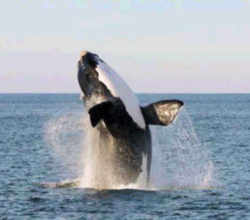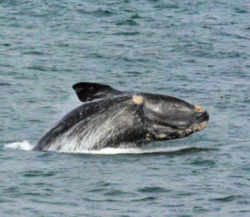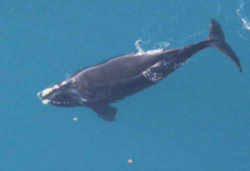
South Carolina Symbols
South Carolina State Migratory Marine Mammal
Right Whale

(Eubabalena glacialis)
Adopted on June 3, 2009.
The Northern Right Whale was designated as the official State Migratory Marine Mammal by Act Number 58 of 2009. The right whale is a large, bulky baleen whale that is black all over with the exception of its white belly. Adults are generally 35 to 55 feet and can weigh over 100 tons. Females are larger than males. The right whale can be found off the South Carolina coast during the breeding and calving season. Although the right whale has been protected since the 1930s, it is still an extremely endangered species.
South Carolina State Migratory
Marine Mammal:
Right Whale

Right whales are three species of large baleen whales of the genus Eubalaena: the North Atlantic right whale (E. glacialis), the North Pacific right whale (E. japonica) and the southern right whale (E. australis). They are classified in the family Balaenidae with the bowhead whale. Right whales have rotund bodies with arching rostrums, V-shaped blowholes and dark gray or black skin. The most distinguishing feature of a right whale is the rough patches of skin on its head which appear white due to parasitism by whale lice. Right whales can grow up to 18 m (59 ft) long and weigh up to 100 short tons (91 t; 89 long tons), significantly larger than humpbacks or grays, but smaller than blues.
The Right Whale, (Eubabalena Glacialis,) is a large, blackish whale with the following features: no dorsal fin; head huge, about one-fourth of total length; baleen (whalebone) about 2 m long, 30 cm wide, and between 200 and 250 in number on each side of mouth; closure of mouth highly arched; no furrows on the throat; prominent, large, wartlike areas (called bonnets), the one near tip of snout largest. Total length of adults, 14-17 m; weight, 20-30 metric tons.
Right whales were so named by early whalers because they were the "right" whale to kill - they are slow swimmers and were thus easily caught, floated
when dead, and produced large quantities of oil and baleen. Consequently, right whales were decimated early by the world's whaling industries and have
yet to recover.
Right whales spend spring, summer, and autumn at high latitude feeding grounds and migrate to more southerly, warmer waters in winter for mating and
calving. Northern and southern populations do not interbreed due to asynchronous seasons between the hemispheres.
 Right whales produce a variety of vocal sounds
as well as percussive sounds of breaching, flipper slapping, and tail slapping. A distinctive clacking sound has been described for these whales as
they feed at the surface. Termed the "baleen rattle," this sound is produced by small wavelets rattling the baleen plates when they are partially held
out of water. Right whale sounds appear to differ with changing behavior and, thus, may be important in communication. As with other baleen whales,
right whales probably do not echolocate.
Right whales produce a variety of vocal sounds
as well as percussive sounds of breaching, flipper slapping, and tail slapping. A distinctive clacking sound has been described for these whales as
they feed at the surface. Termed the "baleen rattle," this sound is produced by small wavelets rattling the baleen plates when they are partially held
out of water. Right whale sounds appear to differ with changing behavior and, thus, may be important in communication. As with other baleen whales,
right whales probably do not echolocate.
Right whales feed by skimming through concentrations of krill. They have been seen feeding at depths ranging from the surface down to 10 m although
they may also feed at deeper levels. Location of krill concentrations in the water column probably determines feeding depth.
After a one-year gestation period, females give birth to a single calf in winter. Calves are 5-6 m in length at birth but grow rapidly during the subsequent
period of lactation, which lasts about 13 months. Calves remain with their mothers for 2-3 years following weaning and probably reach sexual maturity
at about 10 years of age. Females give birth at 2 to 7 year intervals.
Status
The North Atlantic right whale (Eubalaena glacialis) is the largest endangered whale in the world, according to the National Oceanic and Atmospheric Administration, and was nearly hunted to extinction in the 19th and early 20th centuries. Whalers considered the animals the "right" whale to hunt, because t was bslow moving, migrated close to shore and stayed afloat after being killed.
The right whales have been protected from hunting since 1935. While whaling activities have since decreased, the right whales face serious risks from ship collisions and entanglements in fishing gear and marine debris, which is the problem faced by the yearling dubbed "Kingfisher" off the coast of the Carolinas. More than half of the adult population carries scars likely related to entanglements.
NOAA estimates the North Atlantic right whale population at 300 to 350 animals, mostly living in the waters of the North Atlantic (hence the name) in five areas: off the Southeastern US, Cape Cod Bay and the Great South Channel off Massachusetts, and the Bay of Fundy and the Scotian Shelf off Canada.
The species is listed as "Endangered"under the US Endangered Species Act of 1973. Right whales and all other species of marine mammals are also protected under the US Marine Mammal Protection Act of 1972.
South Carolina Law
The law designating the northern right whale as the official South Carolina state Migratory Marine Mammal is found in the South Carolina Code of Laws, Title 1, Chapter 1, Article 9, Section 1-1-713.
Title 1 - Administration of the Government
CHAPTER 1. GENERAL PROVISIONS
ARTICLE 9. STATE EMBLEMS, PLEDGE TO STATE FLAG, OFFICIAL OBSERVANCES
SECTION 1-1-713.
SECTION 1-1-713. Official state Migratory Marine Mammal.
The "northern right whale" (Eubalaena glacialis) is designated as the official state Migratory Marine Mammal.
Taxonomic Hierarchy: Right Whale
Kingdom: Animalia
Phylum: Chordata
Class: Mammalia
Order: Cetartiodactyla[a]
(unranked): Cetacea
(unranked): Mysticeti
Family: Balaenidae
Genus: Eubalaena
Species: E. glacialis - (Muller, 1776)







